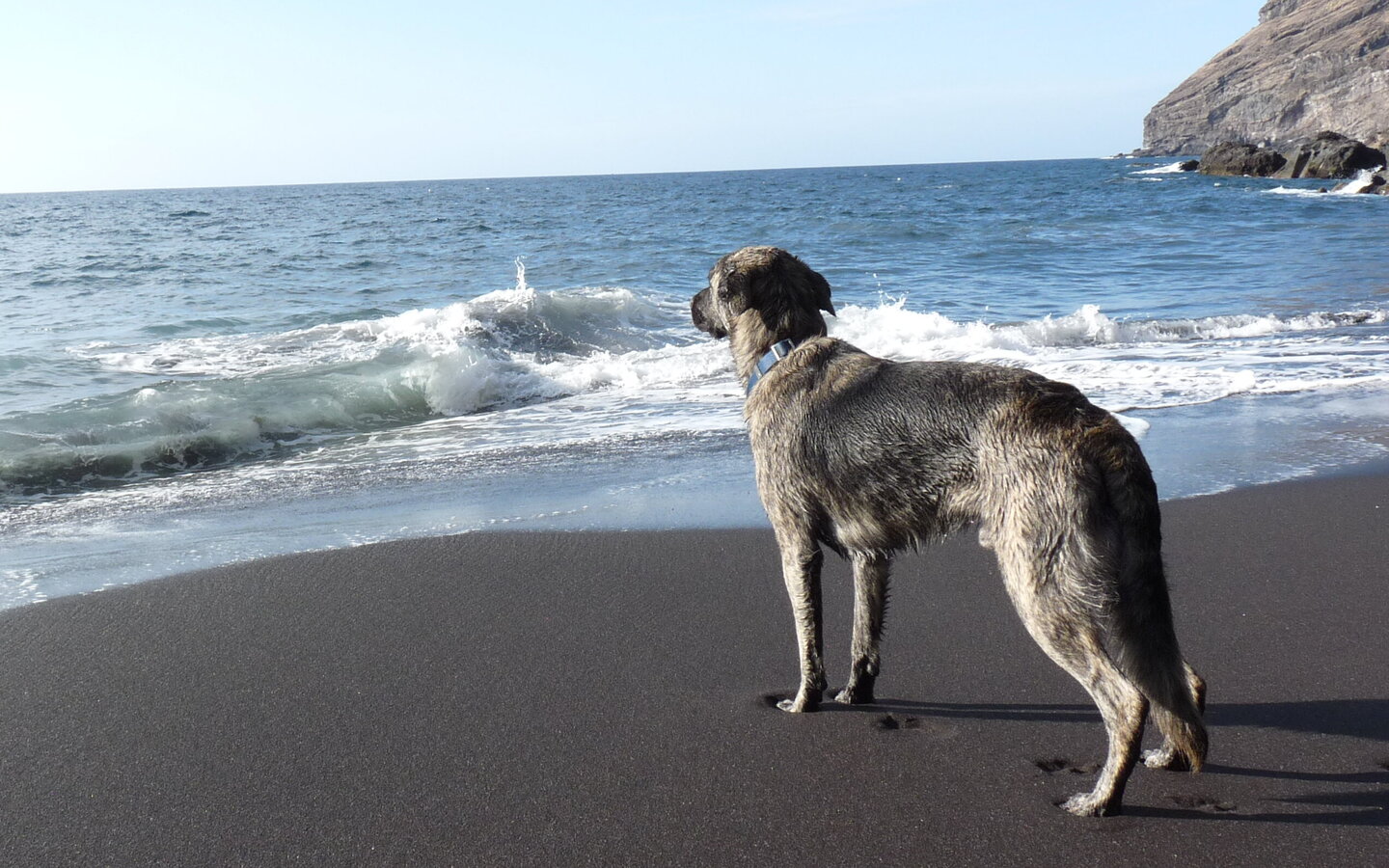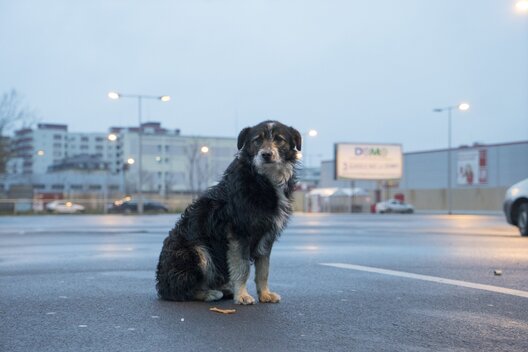Should I take my dog with me on vacation?These factors must be taken into account when making a decision:

How far away is the destination? How do you travel, e.g. by car, ferry or plane?

What is the climate like at the destination? What kind of accommodation do you stay in?

How old is the dog? What is its state of health? What breed does it belong to? What are its character & behavior?

Can I take my dog with me to the vacation destination? What conditions must be met? What vaccinations and papers are required?
It is an individual decision whether your dog should go on vacation with you. Dogs react very differently to car journeys, transportation and changes of location. Some animals don't mind traveling. For others, it sometimes means considerable stress, so that it is better to look after them at home.
The most comfortable way for dogs to travel is usually in an air-conditioned car. At best, they are used to this mode of transportation and a dog crate from everyday life and have no negative associations with it.
Meanwhile, taking short-headed dogs such as Pugs or French and English bulldogs to hot regions can be life-threatening - this also applies to summer vacations in Germany. These extreme breeds already have breathing problems and find it difficult to regulate their body temperature.
Before you decide to take your dog on vacation with you, you should find out whether there is an increased risk of transmitting certain infectious diseases at your destination.1 In many popular vacation destinations there are diseases that do not yet exist in Germany, so-called Vector borne diseases (VBDs) such as babesiosis, dirofilariosis and leishmaniasis. These diseases can be dangerous for dogs and some of them are potentially transmissible to humans.
Sand flies, which live in warm regions such as Italy, Spain, Greece, Romania and North Africa, transmit Leishmania. To avoid infection, you can use spot-on preparations or oral medication, put a mosquito net over your dog's sleeping area and avoid walking your dog in the evening. You can discuss which is best for your dog with a vet.
The safest way to protect your pet from Vector borne diseases is not to take it to affected regions in the first place.
Various Vector borne diseases are now also present in this country, partly due to climate change. You should therefore deworm dogs all year round and protect them from ticks, fleas and the like.
Make sure you check whether your dog is allowed in the hotel and on the beach - even if you are on vacation within Germany. In Germany, for example, the Baltic and North Seas, Lake Constance, the Mecklenburg Lake District, the Harz Mountains and the region around the Moselle are easily accessible vacation destinations with dogs. However, dogs are often not allowed on Baltic Sea beaches, especially in the high season and during school vacations. If it is very crowded with holidaymakers, this can also cause stress for dogs (and their owners).
When traveling abroad, it is important that you find out about the relevant laws and regulations in advance. For example, some countries require dogs to be muzzled. In some countries, the entry of certain dog breeds and their hybrids is prohibited. Denmark , for example, bans 13 dog breeds under its dog law. You can find out which breeds are affected on the website of the Danish Ministry of Foreign Affairs.
- Securing your dog
According to road traffic regulations, an animal in the car counts as cargo - so you must secure it in the vehicle accordingly. The best way to do this is to use sturdy transport boxes in the trunk of the car. However, certified belt systems that you attach to the car's existing system are also suitable for a safe journey. - Prevent travel sickness
As some dogs become nauseous after a large meal on car journeys, it can be a good idea not to set off until a few hours after feeding. - Take breaks
Plan sufficient breaks for short walks so that your dog can move around and get some fresh air. During the breaks, you should offer him water and, if necessary, small amounts of food. - Choose cooler travel times
If possible, plan your journey for the cooler morning or evening hours to avoid problems with heat. - NEVER leave your dog in the car
Never leave your dog in a closed car, as there is not enough air circulation even with the windows open. Stationary air conditioning systems can also be defective. You should therefore not leave your dog in the car even if it is working. - No draughts
The dog should not be exposed to draughts while driving, as otherwise it can easily develop conjunctivitis.
All information refer to a journey with Deutsche Bahn. Please get informed if you intend to travel with another train company.
- Abroad: dogs allowed on trains?
When traveling abroad, find out whether dogs are allowed on trains in the respective country. - Additional ticket for your dog
Small dogs, up to the size of a domestic cat for example, are allowed to travel free of charge in a transport container in Germany. For larger dogs and international journeys, you will need an additional ticket. The fare is usually 50 percent of the normal fare. - Leash & muzzle
You must always carry a leash and muzzle for your dog. It is also advisable to always take a portable water bowl with you. - Plan plenty of time
Allow enough time to change trains and move around
You should always avoid transporting animals on airplanes, as flying is extremely stressful for all animals. Small dogs are allowed to fly in the passenger cabin, while large dogs are checked in like luggage and fly in the cargo hold. Both situations are extremely stressful for your pets. Ideally, you should therefore switch to another means of transportation.
If you are planning to take your dog on a boat trip or if a ferry trip is necessary on your journey, you should clarify before departure whether animals are allowed on board and how they will be accommodated. Some ferries do not allow the animal to leave the car, the transport box or a kennel on deck during the crossing. This can be stressful for the dog due to temperature fluctuations and noise levels in the cargo hold. Cruise ships generally do not allow animals on board.
Since 2004, dog owners crossing borders within the EU must carry an EU pet passport. You can obtain this from your vet. Your dog must also be chipped with a transponder and have a valid anti-rabies vaccination.
Please obtain information on entry regulations from the competent authority in your country and, if applicable, the customs or foreign office of the country you are traveling to.
If you want to take so-called listed dogs such as a pit bull or bull terrier with you, you should enquire about the current regulations at the embassy of the respective country before entering the country. This is because which dog breeds are prohibited or subject to certain conditions varies from country to country.
If you are planning a vacation with a dog, you should seek veterinary advice in good time. We recommend a visit at least three months before you travel. Your dog needs a valid rabies vaccination to travel within the EU. Depending on the destination, a rabies antibody test may also be required. Some countries, such as Great Britain, Ireland and Malta, have additional requirements. You should also discuss travel precautions and a potential first-aid kit in detail with your vet so that you can provide your pet with the best possible protection on vacation.
Regardless of your travels, your dog should be chipped and registered. If you have your pet identified and then register it with FINDEFIX, the pet register of the German Animal Welfare Federation, you have a good chance of seeing your pet again - even on vacation.
We protect animals missing abroad by exchanging information with databases all over the world. If your dog gets lost while you are on vacation, please report it either via the FINDEFIX online form or via the 24-hour service telephone: +49 (0) 228 6049635. Please also inform your local animal welfare association, the police and the nearest lost and found office, as finders often turn to one of these offices first.
The best person to look after your dog is someone you know and trust - for example a friend, family member, neighbor or acquaintance. You should trust the person to look after your pet. Ideally, it should be someone who already knows the animal.
If this is not possible, we recommend that you contact your local animal welfare organization or animal shelter with this question. They may know people who love animals and to whom you can entrust your pet. In any case, there should always be a detailed preliminary discussion and a personal meeting.
Before you decide on a boarding kennel, it is important that you find out about the kennel in question, for example from your local animal welfare organization. Complaints are usually known there. Have a look at the boarding kennel well in advance of your vacation. It is not a good sign if you are not allowed to inspect the area where the animals are housed. You can find more information in our leaflet Tips for assessing a boarding kennel.
Sources and further reading
1 https://www.esccap.de/experten-tipps-zum-schutz-vor-reisekrankheiten
Fact sheet: "Tips for assessing a boarding kennel" (available in German only)





